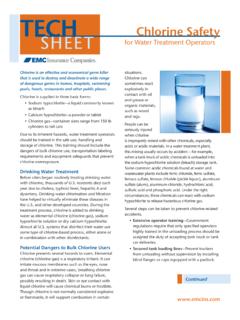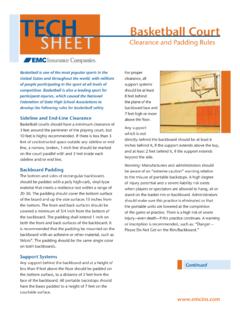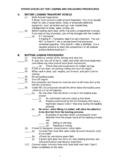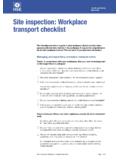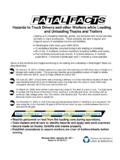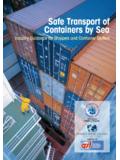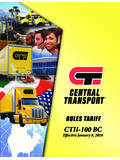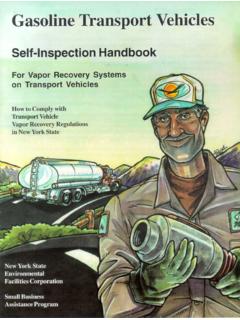Transcription of Bulk Fuel Loading - EMC Insurance Companies
1 bulk fuel Loading bulk fuel Loading operations can be conducted more fill connection. safely if basic safety practices are implemented. These Wiring of this range from bonding and grounding requirements to type is commonly vehicle location, and each is important to the operation referred to as of a safe bulk fuel facility. Each facility of this type is explosion proof . unique and should be evaluated according to guidelines and uses ridged, outlined in NFPA , ANSI and local and regional codes threaded conduit. and statutes. bulk fuel facilities should implement the This type of wiring following safety practices, at a minimum. should be used for all lights, motors, Loading Location Relationship to Exposures switches, phones Tank trucks with Class I liquids should be parked at and other electrical least 25 feet from above-ground tanks, warehouses, equipment within the distance requirements.
2 Buildings and property lines, while tank trucks with Class II and Class III liquids should be parked at least Fire Prevention and Control 15 feet from the above entities. Open flames and Precautions should be taken to prevent the ignition smoking should not be allowed within 25 feet of of flammable vapors. Ignition sources should be fuel -transferring operations. removed or strictly controlled within 25 feet of fuel transfer operations, while driving the vehicle or when Self-Closing Loading Riser Valves making repairs. bulk fuel plants and tank trucks Self-closing Loading riser valves should be used to should be equipped with fire extinguishers with a control the flow of liquid when top- Loading a tank minimum rating of 40 B:C.
3 No Smoking signs should vehicle with Class I or Class II liquids. These valves be posted at the Loading rack, unloading risers, tanks could be operated by either manual or automatic and at all access points throughout the plant. shutoff systems. Automatic shutoff systems should be provided with a manual shutoff valve located at Pumps, Piping and Switches a safe distance from the Loading nozzle, in case the Pumping and piping equipment for each class automatic system fails. of liquid should be separated to avoid cross- contamination. All switches and piping should be Fill Extensions labeled or color-coded to indicate the type of product A fill extension downspout that extends to within they contain or control.
4 6 inches of the bottom of the tank should be used when filling open-dome vehicles in which a flammable range vapor/air mixture could exist. Electrical Equipment When Class I liquids are being handled, all electrical Continued equipment within 3 feet of the fill connection should be Class 1 Group D, Division 1 rated. Division 2-rated electrical equipment should be used when Class I. liquids are being handled between 3 and 15 feet of the bulk fuel Loading Vehicles and Drivers Unloading Risers All unloading risers should be Engines should be shut off and parking brakes should equipped with backflow check valves to prevent be set before any fuel transfer begins.
5 All inspections, the product from flowing out of the bulk plant. The recordkeeping and testing should comply with unloading risers should have substantial support Department of Transportation (DOT) guidelines. between the backflow check valve and the end of Motor vehicle records should be reviewed annually the riser that connects to the transport. This support for all current drivers and before assigning newly should be able to withstand a pull away from a hired personnel to driving positions. transport while the hose is still connected to the unloading riser. Static Bonding and Grounding Top Loading Static electricity is created by a build-up Dike Impoundment of differently charged ions and occurs naturally when Tanks containing Class I or II liquids should be objects (including liquids and gases) move against surrounded by a dike constructed of earth, steel, one another.
6 This type of build-up can take place concrete or solid masonry, and designed to be liquid when liquid products are top-loaded into tanks. The tight in order to withstand the full hydrostatic pressure build-up can produce a static electrical spark between of the liquid. The capacity of the dike should not be less the Loading nozzle and the tank opening or cover. If than the capacity of the largest tank within the dike. flammable vapors are present when the spark occurs, an explosion or fire can result. To minimize this risk, Liquid Containment it is important to use a static bonding cable when All tanks should have a means to contain liquid in the flammable or combustible liquids in temperatures event of an emergency fire.
7 This can be accomplished above the flash points of the liquids are transferred by having an actuated valve that snaps shut in the between containers. The purpose of the bonding cable event of a fire, or by always keeping the valves and is to equalize the static electrical charge and prevent a covers closed. Make sure all fire safety equipment is static spark. Before Loading tank vehicles through open well-maintained and in working order. dome covers, make a bonding connection between For Additional Information the Loading tank and the vehicle or tank before dome National Fire Protection Association: covers are raised. It should remain in place until filling is completed, and all dome covers have been closed and NFPA 30 Flammable and Combustible Liquids secured.
8 The static bonding/grounding cable should Code be connected to the Loading piping, tanks and a metal Independent Petroleum Association of America: stake installed at least 7 feet into the earth. Bottom Loading An automatic shutoff system Department of Transportation: should be used when bottom Loading a tank vehicle, to ensure that only a predetermined quantity of liquid is loaded and to also prevent overfilling. All connecting components between the Loading rack and the tank vehicle must be functionally compatible. The Loading hose or pipe and the truck should only be connected by a dry disconnect coupling. Home Office: 717 Mulberry St. | Des Moines, IA 50309 | 800-447-2295 | Disclaimer: This material is designed and intended for general information purposes only, and is not intended, nor shall be construed or relied upon, as specific legal advice.
9 Copyright Employers Mutual Casualty Company 2014. All rights reserved. 6156 (4-14).


